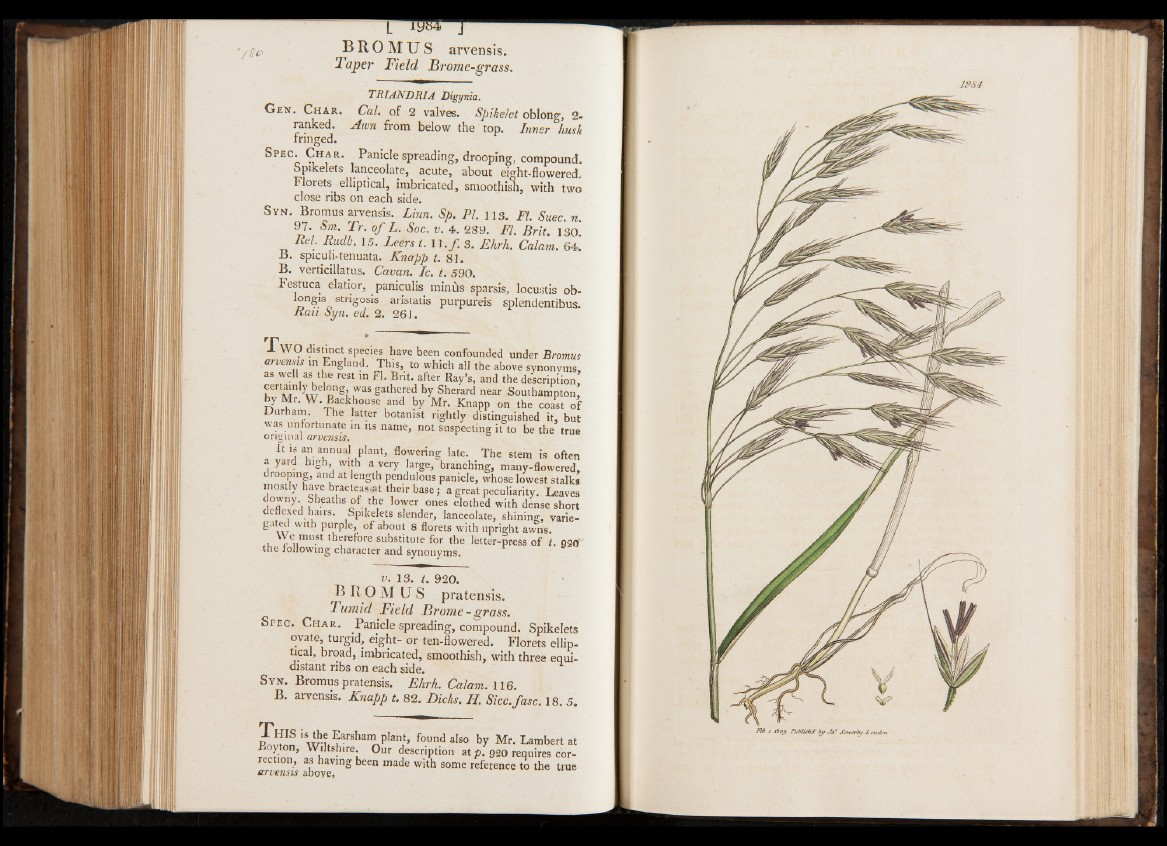
B R O M U S arvensis.
Taper Field, Brome-grass.
TRIANDRIA Digyvia.
G en. C har. Cal. of 2 valves. Spike/et oblong, 2-
ranked. Awn from below the top. Inner husk
fringed.
Speo. Char. Panicle spreading, drooping, compound.
Spikelets lanceolate, acute, about eight-flowered.
Florets elliptical, imbricated, smoothish, with two
close ribs on each side.
Syn . Bromus arvensis. Linn. Sb. P I. \ \s. F l Suer »
9 7 . Sm, Tr. o fL . Sac. v . 4 . 2 8 9 . FL Brit. 130
Rel. Rudb. 15. Leers i. 11 . f 3. Ehrh. Calam. 64.
B . spiculi-tenuata. Knapp t. 8 1 .
B. verticillatus. Cavan. Ic. t. 590.
-Festuca elatior, paniculis minus sparsis, locustis ob-
° n?.’sr, stl'igos‘s aristatis purpureis splendentibus.
Rail Syn. ed. 2. 261.
T W O distinct species have been confounded under Bromus
aivensis in England. This, to which all the above synonvms,
as well as the rest in Fl. Brit, after Ray’s, and the description!
'ong? u aS Sathcred hy Sherard near Southampton,
by Mr. W . Backhouse and by Mr. Knapp on the coast of
Durham. The latter botanist rightly distinguished it, but
was unfortunate in its name, not suspecting it to be the true
original arvensis.
ft is an annual plant, flowering late. The stem is often
a yard high with a very large, branching, many-flowered,
drooping, and at length pendulous panicle, whose lowest stalks
mostly have bracteas^t their base; a great peculiarity. Leaves
downy. Shpths of the lower ones clothed with dense short
deflexed hairs. Spikelets slender, lanceolate, shining, varie-
gated with purple, of about 8 florets with upright awns.
We must therefore substitute for the letter-press of t. 920
the following character and synonyms.
V. 13. t. 920.
B R 0 MUS pratensis.
Tumid Field Brome-grass.
S pec. C har. Panicle spreading, compound. Spikelets
ovate, turgid, eight- or ten-flowered. Florets elliptical,
broad, imbricated, smoothish, with three equidistant
ribs on each side. ^
Syn. Bromus pratensis. Ehrh. Calam. 116.
B . arvensis. Knapp t. 82. Dicks. H. Sicc.fasc. 18. 5 .
ï g ? istheEarshani plant, found also by Mr. Lambert at
JBoyton, Wiltshire. Our description at p. 920 requires correction,
as having been made with some reference to the true
arvensis above.
FH x x8oy P ublufid by J a f Aowcrby 2. enden